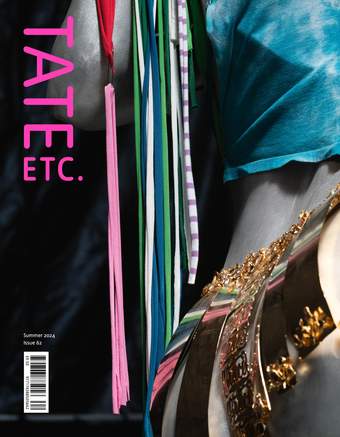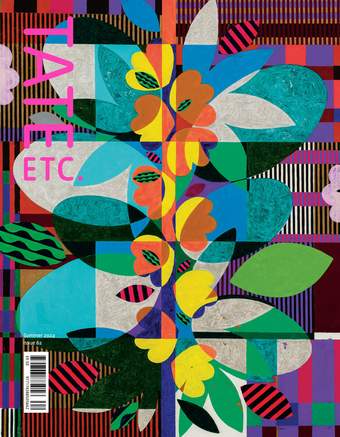'As a girl, then woman, and eventually a mother in the Caribbean diaspora in London, I learnt from my grandma Umilta that one way to cheer a fractious baby was to dance and repeat, child on hip, ‘a-ping pang pang…’, an imitation of the sound of a steel pan. My cousins and siblings delighted in the rowdy faraway fragment of the steel pan sung for us, but knew too the losses and longing it voiced.’
So writes curator Dominique Heyse-Moore in her essay ‘Pang Pang’, which explores both her own private family history, and Alvaro Barrington’s Tate Britain commission, Grace – a monumental reimagining of Black culture and aspirational attitudes. Grace is, as Barrington has said, a tribute to his own personal graces – his grandmother, mother, and sister – who ‘showed up gracefully’. It is also a dedication to carnival – and to the transgressive, emancipatory power of carnival traditions across the Caribbean and worldwide. Rain falls on a tin roof, music echoes, light shines through in a variety of colours, and a dancer – grace embodied – emerges from a sea of steel pans.
This issue of Tate Etc. is dedicated to that commission, with a range of features expanding on and reflecting its message. The spirit of carnival can be found across Tate this summer: in Zanele Muholi’s breathtaking exhibition, and photographs which ‘break the surface’ of all our lives; in Oscar Murillo’s new project, The flooded garden, an immense participatory work opening soon at Tate Modern; and in Beatriz Milhazes’ exhibition Maresias at Tate St Ives.
Welcome to summer,
Tate Etc.


Contents
A Mystery at Play: By Kaushalia Khanna
After moving from India to the UK in the early 1960s, Balraj Khanna became a distinguished painter in the British …
Flashes of Inspiration
The exuberant performance artist Monster Chetwynd reveals her sources of inspiration, past and present
Taste Etc: Ghetto Gastro
Red Drank
In Our Hands
Each picture in Zanele Muholi’s photo series Somnyama Ngonyama challenges us to reconsider the possibilities of self and environment, writes …
Latitude of Myths
In Firelei Báez’s vast, irrepressible painting, a mythical Ciguapa disrupts the map, writes Momtaza Mehri
Present in Absentia
For Mike Phillips, the interactive Psalms stores a tangible memory of his late friend and collaborator Donald Rodney
Body Language
Eisa Jocson finds in one painting echoes of her own choreographic work which unpacks the presentation of femininity
Petrit Halilaj
The artist grants us a peek into the thinking behind his playful, wearable moth sculptures
A Home and a Sanctuary
Matthew Phillip, CEO of Notting Hill Carnival, shares his earliest memories of the annual event, and reflects on its …
Pang Pang: By Dominique Heyse-Moore
Like the ‘protective culture’ of carnival, Alvaro Barrington’s new commission offers a warm, resounding welcome to the historic galleries at …
The flooded garden
This summer, Oscar Murillo will transform the Turbine Hall through a monumental participatory painting project inspired by Monet’s Water Lilies …
A Caribbean Emblem
To celebrate 60 years since the unveiling of Ronald Moody’s only public sculpture, Ego Ahaiwe Sowinski tells its story
A Thousand Queer Gardens
Daisy Lafarge discovers Mary Delany’s trove of botanical specimens, which burst through the strictly guarded borders of 18th-century gender
‘What would a man do?’
Once dubbed ‘the great offender’, Caroline Coon enjoys revisiting the ‘transformative masquerade’ of her oil painting Self in Cock Mask
No Fixed Horizon
Paul Pfeiffer’s 2003 film on JMW Turner’s Morning After the Deluge explores the uncanny notion that perception isn’t stable …
Conceptual Carnivalesque
Since the 1980s, Beatriz Milhazes has been making paintings that combine modernist geometric abstraction with the energy and imagery of …
Agony Artist: Dear Mx Mavis
In their last advice column for Tate Etc., Mx Mavis (AKA artist and sex activist Ajamu X) tackles your most …


